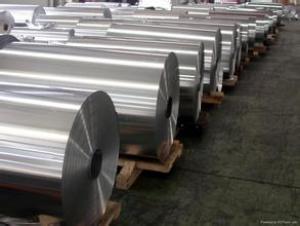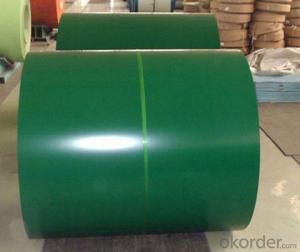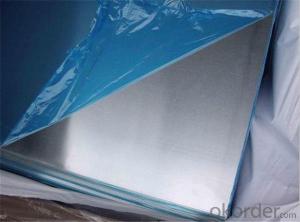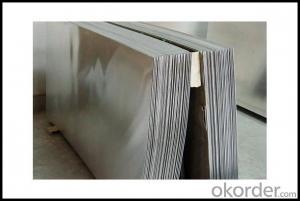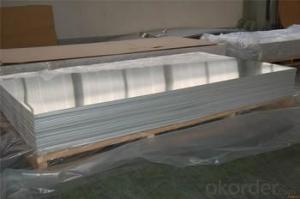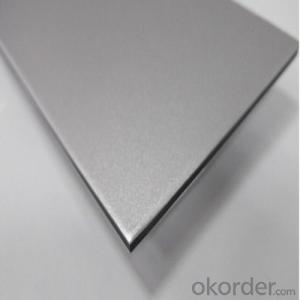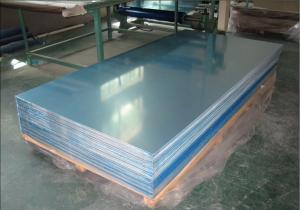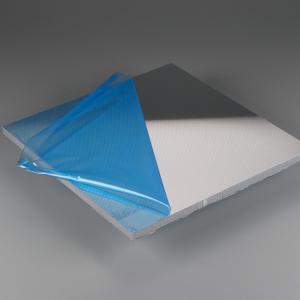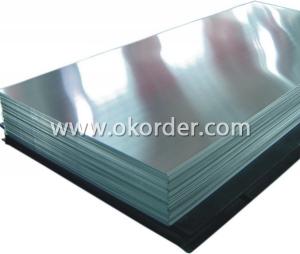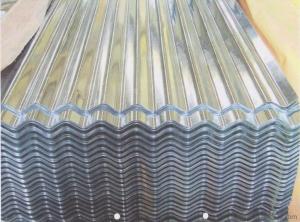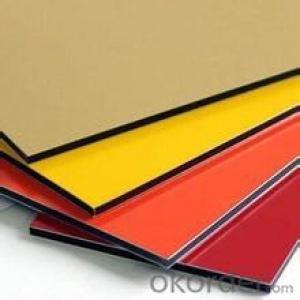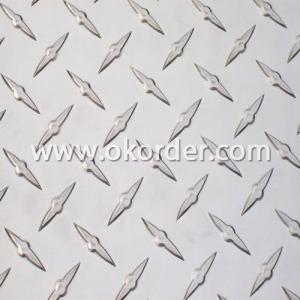Anodized Aluminum Sheets - Wholesalers Aluminum Sheet Product Manufacturers
- Loading Port:
- China main port
- Payment Terms:
- TT or LC
- Min Order Qty:
- 3 m.t.
- Supply Capability:
- 3000 m.t./month
OKorder Service Pledge
OKorder Financial Service
You Might Also Like
ALLOY: AA1***(AA1050,AA1060,AA1070,AA1100etc)
AA3***(AA3003, AA3004,AA3005, AA3105etc)
AA5***(AA5052,AA5083,AA5754 etc)
TEMPER: H14,H16,H18,H22,H24,H26,H32,O/F
THICKNESS: O.O3mm-3.0mm
WIDTH: 30mm-1700mm
COATING: PE(POLYESTER),PVDF,EPOXY
PAINTING THICKNESS: STANDARD 16-25 MIC, MAX 40 MIC
COLOR: ACCORDING TO RAL COLORS OR CUSTOMER'S SAMPLES

1, Aluminum sheet with a large amount of water for the first time;
2,With a soft cloth to wipe the surface with water diluted detergent gently wipe;
3, Aluminum sheet with a large number of water washing plate, the dirt will be washed away;
4, Check the aluminum sheet, for no clean place with cleaning agent cleaning key;
5, Aluminum sheet with clear water rinse, to be clean.
Note: do not wash the hot plate (temperature above 40 degrees Celsius), because excessive evaporation of water is harmful to the surface paint!
Special need to pay attention to, please select the appropriate detergent, a basic principle is: be sure to use a neutral detergent! Please do not use strong alkaline detergent, such as potassium hydroxide, sodium hydroxide or sodium carbonate, strong acid detergent, detergent and paint dissolution of detergent.

- Q: How is the strength and durability of aluminum sheets determined?
- The strength and durability of aluminum sheets are determined through a variety of testing methods and parameters. One of the primary factors that determines the strength of aluminum sheets is the alloy composition. Different alloy compositions have varying levels of strength, and certain elements added to the aluminum can enhance its strength properties. To evaluate the strength of aluminum sheets, tensile testing is commonly employed. This involves subjecting a sample of the sheet to tension until it fractures. During the test, the load and deformation are measured, and the ultimate tensile strength (UTS) and yield strength are determined. UTS represents the maximum stress the sheet can withstand before failure, while yield strength is the stress at which the material begins to deform plastically. Another important consideration for determining the strength and durability of aluminum sheets is the thickness. Generally, thicker sheets tend to be stronger and more durable than thinner ones due to the increased cross-sectional area contributing to load-bearing capacity. In addition to alloy composition and thickness, the manufacturing process also affects the strength and durability of aluminum sheets. Factors such as rolling and heat treatment can alter the microstructure of the aluminum, influencing its mechanical properties. Proper control of these processes helps ensure consistent strength and durability across the sheets. Furthermore, aluminum sheets are often evaluated for their resistance to corrosion. Aluminum naturally forms a protective oxide layer, which contributes to its corrosion resistance. However, specific coatings or treatments can be applied to enhance this resistance, depending on the intended application. In summary, the strength and durability of aluminum sheets are determined through a combination of alloy composition, thickness, manufacturing processes, and testing methods such as tensile testing. These factors collectively dictate the mechanical properties and resistance of aluminum sheets to various forms of stress, making them suitable for a wide range of applications.
- Q: Can aluminum sheet be used for medical applications?
- Yes, aluminum sheet can be used for certain medical applications. Aluminum is a lightweight and durable material that is resistant to corrosion, making it suitable for various medical devices and equipment. For example, aluminum sheets can be used for manufacturing prosthetic limbs, braces, and orthopedic implants. Additionally, aluminum can be used in the production of medical instruments, such as surgical trays, sterilization containers, and imaging equipment. However, it is important to note that aluminum may not be suitable for all medical applications, as certain medical devices may require specific properties or materials to meet regulatory standards and ensure patient safety. Therefore, the use of aluminum sheet in medical applications should be determined on a case-by-case basis, considering the specific requirements and regulations of each application.
- Q: Should I purchase a camper made out of aluminum/wood or a fiberglass?I'm looking to purchase a small camper, approx 18', to tow on the back of my SUV. It's a 2011 Wildwood camper. However, I hear campers made out of aluminum and wood aren't very good because the wood can ruin in time and the aluminum can rust, etc. I hear fiberglass campers are better? Anyone have any knowledge or experience with this? Also, any thoughts or advice with brands/models? And about the Wildwood? Thanks in advance.
- Aluminum is lighter so it offers economies over the life of the trailer. The Airstream has been built almost as long as I've been around. It is true that the wood does rot And some care is needed to stop the occasional leak. Fiberglass is heaver and has it's own maintenance issues. I've no experience with the Wildwood. What I do know is that motor homes are dirt cheap right now. You might think about taking advantage of the economy and pick-up a motor home at a bargain.
- Q: Can aluminum sheet be used for medical applications?
- Yes, aluminum sheet can be used for certain medical applications. Aluminum is a lightweight and durable material that is resistant to corrosion, making it suitable for various medical devices and equipment. For example, aluminum sheets can be used for manufacturing prosthetic limbs, braces, and orthopedic implants. Additionally, aluminum can be used in the production of medical instruments, such as surgical trays, sterilization containers, and imaging equipment. However, it is important to note that aluminum may not be suitable for all medical applications, as certain medical devices may require specific properties or materials to meet regulatory standards and ensure patient safety. Therefore, the use of aluminum sheet in medical applications should be determined on a case-by-case basis, considering the specific requirements and regulations of each application.
- Q: 1. Esrp for aluminum is -1.66V. Why is Al not reactive when dipped in cold water?2. Explain why the reaction between water and Al becomes more reactive when Al has been treated first with Mercury chloride.3. Aluminum hydroxide dissolve in both acid and base. What do you call this type of behavior?4. Describe the function of aluminum hydroxide in the testile industry.5. Aluminum sol. which contains [Al(H2O)6]3+ ions have the tendency to hydrolyze. Why? Recommend a method to prevent hydrolysis of aluminum ions.6. In the preparation of alum, sulphuric acid is added to the aluminum hydroxide sol. Why?
- Al is not reactive because it is so reactive - it gets coated with oxide immediately on exposure, the oxide layer is strong and quite inert except to strong acids.
- Q: What is the melting point of 101 aluminum sheets?
- The melting point of 101 aluminum sheets is approximately 660 degrees Celsius or 1220 degrees Fahrenheit.
- Q: Is aluminum sheet magnetic?
- No, aluminum sheet is not magnetic.
- Q: I want to make a dress from aluminum cans. However, aluminum is very sharp once cut. So, do you thing there is a possible way to make the cut edges less sharp? Would sanding the edges help?
- It's a soft metal so sanding and filing would work. You could also consider folding over the sharp edges (like a hemline) using a pliers or similar tool
- Q: Can aluminum sheets be used for chemical reactors?
- Certain applications allow for the use of aluminum sheets in chemical reactors. Aluminum possesses excellent corrosion resistance, rendering it appropriate for diverse chemical reactions. Nevertheless, it is crucial to take into account the nature of the chemicals employed and their potential reactivity with aluminum. In highly acidic or alkaline environments, aluminum's reactivity and susceptibility to corrosion should be duly recognized. Furthermore, specific gases or elevated temperatures may render aluminum unsuitable for reactions. In such instances, alternative materials such as stainless steel or glass-lined reactors might prove more fitting.
- Q: is steel better for making bicycle frames.....how does it differ from the aluminum framed bikes?
- Steel is better for road bikes and touring bikes, while aluminum is better for race bikes because its lighter. Steel will rust, so if you have a bike where it rains a lot or you ride in the winter, you need to apply a coat of Frame Saver every year to keep the inside of the frame rust-free.
Send your message to us
Anodized Aluminum Sheets - Wholesalers Aluminum Sheet Product Manufacturers
- Loading Port:
- China main port
- Payment Terms:
- TT or LC
- Min Order Qty:
- 3 m.t.
- Supply Capability:
- 3000 m.t./month
OKorder Service Pledge
OKorder Financial Service
Similar products
Hot products
Hot Searches
Related keywords
